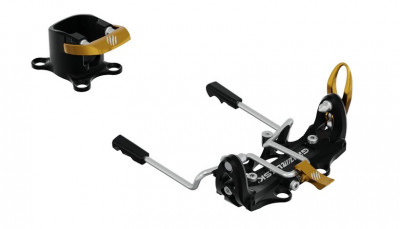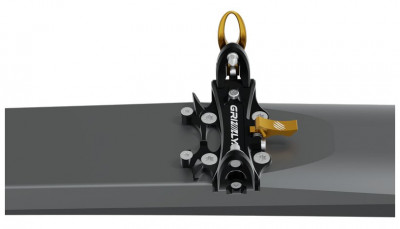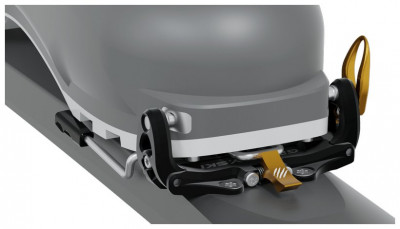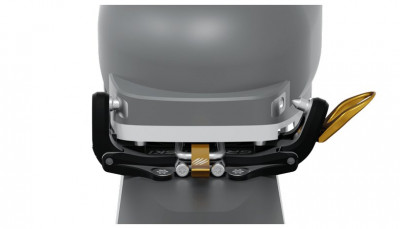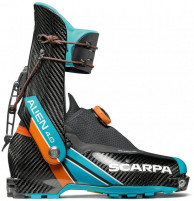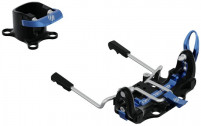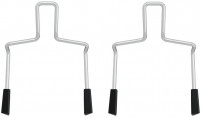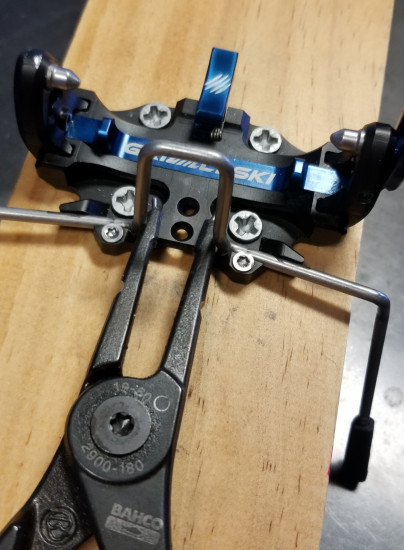Grizzly GR 98 Binding
When Grizzly bindings was founded in 2017, their creator, Jozef Gaborik, was on a mission to create some of the lightest bindings in the world that were functional and reliable. Fast forward a few years and their GR 98 binding nails that criteria. Featuring a removable ski brake, the GR 98 complies with the updated ISMF racing rules that require brakes for competition, while still being crazy light. Jozef even sprinkled in some innovations such as the Grizzly Flex system which allows the pin width to be adjusted to ensure perfect boot compatibility. In addition, the adjustable Grizzly Step makes stepping into the binding much easier, which has the benefit of keeping transition times to a minimum while the clock is ticking. If you’ve been seeking a no-compromise ISMF race companion, then cuddle up with the new Grizzly 98 race binding.
- Unique ski brake is removable so you can strip down to the bare essentials.
- Grizzly Fix toe locking system is simple and reliable to keep from stressing your hypoxic brain.
- Grizzly Flex pin adjustment changes toe width, helping to accommodate any touring boot.
- The swivel heel allows for a defined lateral release and has a simple race flap for uphill.
- Available in two release strengths that change both the vertical and lateral values.
- Lifetime warranty on the heel pins as Grizzly is confident they won't wear or break.
- Fulfills ISMF safety requirements for smooth sailing at check-in.
- Recommended for race skis only (sub 800 grams).
- Made with Alu 7075 and stainless steel.
- Imported from Slovakia.
| Specifications | |
|
Weight |
102g [65mm] |
| Weight (pair) | 204g[65mm] |
|
Boot |
Tech |
|
Brakes |
65, 75 |
|
BSL |
Accessory plates |
|
Riser |
1 |
|
Vertical |
8 or 10 |
|
Lateral |
8 or 10 |
|
Crampon |
No |
| Specs Verified | Yes |
| Design | |
|
|
ALU 7075, stainless steel |
| Skimo Co Says | |
| Usage | World Cup racing |
| Notes | Adjustable pin width helps with step in for quick transitions on race day |
| Bottom Line | The ultimate race binding with brake |
| Compare to other Race Bindings | |
Related Products
Questions & Reviews
They never failed on me and I never crashed hard enough to test the release truly. I had one minimal crash and they stayed on, which was a good thing in the situation. One time the heel piece rotated and released as I tried to quickly get out of them to put on skins. I had to twist it back into place before skinning.
I never experienced flopping of heel mechanism, but if it does happen there does not appear to be any way to tighten it.
I regret buying these. Can’t imagine this company will be around long.
Is there an adjustment to make the open setting more open so the boot fits more easily and yet when closed it is still properly tight and safe?
Unfortunately, there isn't an adjustment for that. However, I personally use the Grizzlies and am also not the most flexible person. Eventually, you'll get a feel for where your foot needs to be and just sort of hover your foot in the binding and close it. It can be every bit as fast as a standard race binding, it just takes practice!
I never got the brakes to reliably deploy. Worse is that the red heel riser softened up during the GT such that I had to tape it down to keep my heel from locking in while skinning. I tried to find a reliable fix to no avail. I contacted Grizly but they didn't respond. Overall, this is the most expensive and worst binding I've ever used in decades of back country skiing (tele and ATl) Unfortunately I have a direct race mount ( no adjustment plate ) so don't have an obvious clean solution to solve the conundrum. I'm definitely disappointed in the binding failing after perhaps 20 hours of use and wouldn't reccomended them to anyone.
I replaced mine with ATK WC revolution. Holes lined up perfectly. So much better, and cheaper.
The brakes are frankly not the most functional out there, but they do work with a little TLC. I found that storing the skis with the brakes deployed helps them to keep their springiness, and you can refresh the brake deployment by opening up the base of the rectangular middle part of the brake using a spreader tool or some rigid pliers. I ended up removing my brakes as the rotation of the boot in my tele turn would often re-lock them anyway. I'm not sure that they would stop the ski in icy or hardpack conditions, but I can't say for sure because toe is strong enough that I have yet to release in the field. Either way, they are a super-light way to meet new ISMF brake requirements.
The GR98 skis well and feels secure. I'm not a huge fan of the way you get in and out of the binding and the brake system has its moments. The side lock to get in and out of the binding (Grizzly Lock) is interesting. It is different and at first I thought it would just take some time to get used to as every other tech binding uses basically the same system with the same general motion.
In my opinion, it's not as efficient and requires more attention than a typical pin race binding toe piece does. It definitely adds more time. I personally find it fine to get into the binding compared to other race bindings but getting out of it just hasn't been as good. My boots constantly get caught in the front pins after I undo the side lever to try and get my boot out of the bindings. On rare occasions I turn my foot at the perfect angle and it comes out smoothly but that's not a regular occurrence.
The brake system also has its moments. One of my brakes deploys most of the time and the other deploys 50% of time when I take my skis off. The one that deploys 50% of time generally requires a manual flick to get it to work for the day. Ice and snow can build up and keep the brake from engaging as well. I like the overall system and placement for the brake but a brake that doesn't engage everytime without help is kinda pointless.
Overall I would say proceed with caution. It certainly could be user error on the transitions but I spend a lot of time skiing and have spent a good amount of time on these bindings and other more traditional tech bindings. The brake issue is annoying as well. Thankfully haven't had a crash or something that would require the brakes to engage but if that ever happens we will see if both brakes engage or not.
- The Olympic has well-defined locked and unlocked modes, with the release testing well in downhill mode. The GR98 in contrast is analogous to an auto-lock binding with one mode. It still does release, but this is not its strongest attribute.
- The brake can be removed from the GR98 but not the Olympic as it's incorporated into the release function.
- The GR98 has adjustable under-boot screws to help with step-in.
- The Olympic can accept crampons whereas the GR98 cannot.
The GR 98 requires a 4mm gap. For future reference, check out our article titled Mind The Heel Gap for a comprehensive list of binding gaps for all of the bindings that we carry. Also, the brakes do not affect the flat uphill mode as this binding does not have one! It can only be used with the race riser. For any further Grizzly binding questions, feel free to reach out to help@skimo.co.
You are out of luck on the heels, as the hole patterns are quite different. The toes of the Plum Race 99 and the Grizzly GR 98 have the same width, and are only off on length by .5mm. While far from ideal, reusing holes would potentially work depending on the mounting plates. For more information on hole patterns, check out our article Hole Pattern Recognition.
Earn store credit by writing reviews. Learn more.






